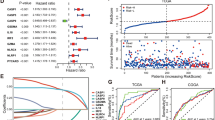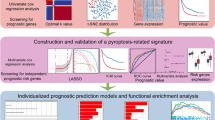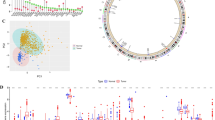Abstract
Pyroptosis, an orchestrated cellular death pathway, has gained attention due to its role in the pathophysiology and evolution of numerous malignancies. Despite this, no robust quantitative measure of pyroptosis activity in lower-grade glioma (LGG) exists currently. We scrutinized the transcriptomic data of LGG specimens acquired from TCGA and CGGA repositories, juxtaposed with the expression patterns of healthy brain tissues from the GTEx database. A register of pyroptosis-associated genes was extracted from the GSEA database. Utilizing unsupervised clustering algorithms on the expression patterns of these genes, we stratified LGG samples into unique subgroups. We implemented the Boruta machine learning algorithm to discern representative variables for each pyroptosis subtype and applied principal component analysis (PCA) to condense the dimensionality of the feature gene expression data, which led to the formulation of a pyroptosis scoring system (P score) to estimate pyroptosis activity in LGG. Furthermore, we affirmed the capacity of the P score to discriminate diverse cell subpopulations within a single-cell database and explored the correlations between the P score and clinical attributes, prognostic implications, and the tumor immune microenvironment in LGG. We identified three distinctive pyroptosis patterns with significant correlations to patient survival, clinicopathological properties, and characteristics of the tumor immune microenvironment (TIME). Two gene clusters, associated with unique prognostic and TIME attributes, emerged from differentially expressed genes (DEGs) across the pyroptosis patterns. The P score was formulated and authenticated as an autonomous prognostic determinant for overall survival in the TCGA and CGGA cohorts. Additionally, the P score demonstrated its competency to quantitatively represent pyroptosis activity across different cellular subpopulations in single-cell data. Notably, the P score in LGG was found to be indicative of tumor stemness and could serve as a predictive biomarker for the efficacy of temozolomide treatment and immunotherapy, underscoring its potential clinical utility. Our investigation pioneers a novel pyroptosis-centric scoring system with significant prognostic implications. The P score holds promise as a potential predictive biomarker for the response to chemotherapy and immunotherapy, facilitating the development of personalized therapeutic approaches in LGG patients.









Similar content being viewed by others
Data Availability
Publicly available datasets were analyzed in this study. This data can be found below:
1.TCGA, https://www.cancer.gov/;
2.GTEx, https://www.genome.gov/Funded-Programs-Projects/Genotype-Tissue-Expression-Project;
3.HPA, https://www.proteinatlas.org/.
Abbreviations
- LGG:
-
Lower-grade glioma
- WHO:
-
World Health Organization
- TIME:
-
Tumor immune microenvironment
- TME:
-
Tumor microenvironment
- TCGA:
-
The Cancer Genome Atlas
- GTEx:
-
Genotype-Tissue Expression
- PRGs:
-
Pyroptosis-related genes
- OS:
-
Overall survival
- ssGSEA:
-
Single-sample gene-set enrichment analysis
- GO:
-
Gene Ontology
- KEGG:
-
Kyoto Encyclopedia of Genes and Genomes
- ICB:
-
Immune checkpoint blockade
- ICPs:
-
Immune checkpoints
- P score:
-
Pyroptosis score
References
Bai D, Feng H, Yang J, Yin A, Lin X, Qian A et al (2021) Genomic analysis uncovers prognostic and immunogenic characteristics of ferroptosis for clear cell renal cell carcinoma. Molecular therapy Nucleic Acids [Internet]. https://doi.org/10.1016/j.omtn.2021.05.009
Bindea G, Mlecnik B, Tosolini M, Kirilovsky A, Waldner M, Obenauf AC et al (2013) Spatiotemporal dynamics of intratumoral immune cells reveal the immune landscape in human cancer. Immunity [Internet]. https://doi.org/10.1016/j.immuni.2013.10.003
Bolstad BM, Irizarry RA, Åstrand M (2003) TPA Speed comparison of normalization methods for high density oligonucleotide array data based on variance and bias. Bioinformatics 19:185–193https://doi.org/10.1093/bioinformatics/19.2.185
Cancer Genome Atlas Research Network, Brat DJ, Verhaak RGW, Aldape KD, Yung WKA, Salama SR et al (2015) Comprehensive, integrative genomic analysis of diffuse lower-grade gliomas. N Engl J Med 372:2481–98. https://pubmed.ncbi.nlm.nih.gov/26061751
Ciardullo S, Muraca E, Perra S, Bianconi E, Zerbini F, Oltolini A et al (2020) Screening for non-alcoholic fatty liver disease in type 2 diabetes using non-invasive scores and association with diabetic complications. BMJ Open Diabetes Res Care 8:e000904. https://pubmed.ncbi.nlm.nih.gov/32049637
Cookson BT, Brennan MA (2001) Pro-inflammatory programmed cell death. Trends in microbiology [Internet]. https://doi.org/10.1016/s0966-842x(00)01936-3
Delgado-López PD, Corrales-García EM, Martino J, Lastra-Aras E, Dueñas-Polo MT (2017) Diffuse low-grade glioma: a review on the new molecular classification, natural history and current management strategies. Clinical & translational oncology : official publication of the Federation of Spanish Oncology Societies and of the National Cancer Institute of Mexico 19. http://www.ncbi.nlm.nih.gov/pubmed/28255650
Finotello F, Trajanoski Z (2018) Quantifying tumor-infiltrating immune cells from transcriptomics data. Cancer immunology, immunotherapy : CII [Internet]. https://doi.org/10.1007/s00262-018-2150-z
Geeleher P, Cox N, Huang RS (2014) pRRophetic: an R package for prediction of clinical chemotherapeutic response from tumor gene expression levels. PloS one [Internet]. https://doi.org/10.1371/journal.pone.0107468
Hänzelmann S, Castelo R, Guinney J (2013) GSVA: gene set variation analysis for microarray and RNA-seq data. BMC bioinformatics 14. http://www.ncbi.nlm.nih.gov/pubmed/23323831
Harada M, Naoi H, Yasuda K, Ito Y, Kagoo N, Kubota T et al (2021) Programmed cell death-1 blockade in kidney carcinoma may induce eosinophilic granulomatosis with polyangiitis: a case report. BMC Pulmon Med 21. http://www.ncbi.nlm.nih.gov/pubmed/33407304
Jiang Z, Yao L, Ma H, Xu P, Li Z, Guo M et al (2016) miRNA-214 inhibits cellular proliferation and migration in glioma cells targeting caspase 1 involved in pyroptosis. Oncol Res 201725:1009–19. https://pubmed.ncbi.nlm.nih.gov/28244850
Jiang P, Gu S, Pan D, Fu J, Sahu A, Hu X et al (2018) Signatures of T cell dysfunction and exclusion predict cancer immunotherapy response. Nature Med [Internet]. https://doi.org/10.1038/s41591-018-0136-1
Karimi E, Yu MW, Maritan SM, Perus LJM, Rezanejad M, Sorin M et al (2023) Single-cell spatial immune landscapes of primary and metastatic brain tumours. Nature [Internet]. 614. http://www.ncbi.nlm.nih.gov/pubmed/36725935
Luo J, Lai J (2022) Pyroptosis-related molecular classification and immune microenvironment infiltration in breast cancer: a novel therapeutic target. J Cell Mol Med [Internet]. https://doi.org/10.1111/jcmm.17247
Malta TM, Sokolov A, Gentles AJ, Burzykowski T, Poisson L, Weinstein JN et al (2018) Machine learning identifies stemness features associated with oncogenic dedifferentiation. Cell [Internet]. https://doi.org/10.1016/j.cell.2018.03.034
McKay RR, Bossé D, Xie W, Wankowicz SAM, Flaifel A, Brandao R et al (2018) The clinical activity of PD-1/PD-L1 inhibitors in metastatic non-clear cell renal cell carcinoma. Cancer Immunol Res [Internet]. https://doi.org/10.1158/2326-6066.CIR-17-0475
Mi H, Ho WJ, Yarchoan M, Popel AS (2022) Multi-scale spatial analysis of the tumor microenvironment reveals features of cabozantinib and nivolumab efficacy in hepatocellular carcinoma. Front Immunol [Internet]. 13. http://www.ncbi.nlm.nih.gov/pubmed/35634309
Panek WK, Kane JR, Young JS, Rashidi A, Kim JW, Kanojia D et al (2017) Hitting the nail on the head: combining oncolytic adenovirus-mediated virotherapy and immunomodulation for the treatment of glioma. Oncotarget [Internet]. 8:89391–405. https://pubmed.ncbi.nlm.nih.gov/29179527
Paw I, Carpenter RC, Watabe K, Debinski W, Lo HW (2015) Mechanisms regulating glioma invasion. Cancer Lett 362:1–7. https://pubmed.ncbi.nlm.nih.gov/25796440
Rogers C, Fernandes-Alnemri T, Mayes L, Alnemri D, Cingolani G, Alnemri ES (2017) Cleavage of DFNA5 by caspase-3 during apoptosis mediates progression to secondary necrotic/pyroptotic cell death. Nat Commun 8:14128–14128. https://pubmed.ncbi.nlm.nih.gov/28045099
Ruan S, Xie R, Qin L, Yu M, Xiao W, Hu C et al (2019) Aggregable nanoparticles-enabled chemotherapy and autophagy inhibition combined with anti-PD-L1 antibody for improved glioma treatment. Nano letters 19. http://www.ncbi.nlm.nih.gov/pubmed/31610656
Sarmiento JM, Venteicher AS, Patil CG (2015) Early versus delayed postoperative radiotherapy for treatment of low-grade gliomas. Cochrane Database Syst Rev 6:CD009229–CD009229. https://pubmed.ncbi.nlm.nih.gov/26118544
Schnappauf O, Chae JJ, Kastner DL, Aksentijevich I (2019) The pyrin inflammasome in health and disease. Front Immunol 10:1745–1745. https://pubmed.ncbi.nlm.nih.gov/31456795
Schumacher TN, Schreiber RD 2015) Neoantigens in cancer immunotherapy. Science (New York, NY) [Internet]. https://doi.org/10.1126/science.aaa4971
Shi J, Gao W, Shao F (2017) Pyroptosis: gasdermin-mediated programmed necrotic cell death. Trends Biochem Sci [Internet]. https://doi.org/10.1016/j.tibs.2016.10.004
Speiser JL, Miller ME, Tooze J, Ip E (2019) A comparison of random forest variable selection methods for classification prediction modeling. Expert systems with applications [Internet]. https://doi.org/10.1016/j.eswa.2019.05.028
Stupp R, Hegi ME, Mason WP, van den Bent MJ, Taphoorn MJB, Janzer RC et al (2009) Effects of radiotherapy with concomitant and adjuvant temozolomide versus radiotherapy alone on survival in glioblastoma in a randomised phase III study: 5-year analysis of the EORTC-NCIC trial. Lancet Oncol [Internet]. https://doi.org/10.1016/S1470-2045(09)70025-7
Topalian SL, Hodi FS, Brahmer JR, Gettinger SN, Smith DC, McDermott DF et al (2012) Safety, activity, and immune correlates of anti-PD-1 antibody in cancer. New Eng J Med [Internet]. https://doi.org/10.1056/NEJMoa1200690
Van Allen EM, Miao D, Schilling B, Shukla SA, Blank C, Zimmer L et al (2015) Genomic correlates of response to CTLA-4 blockade in metastatic melanoma. Science 350:207–11. https://pubmed.ncbi.nlm.nih.gov/26359337
van den Bent MJ (2015) Chemotherapy for low-grade glioma: when, for whom, which regimen?. Curr Opin Neurol [Internet]. https://doi.org/10.1097/WCO.0000000000000257
Wilkerson MD, Hayes DN (2010) ConsensusClusterPlus: a class discovery tool with confidence assessments and item tracking. Bioinformatics (Oxford, England) [Internet]. https://doi.org/10.1093/bioinformatics/btq170
Yu J, Li S, Qi J, Chen Z, Wu Y, Guo J et al (2019) Cleavage of GSDME by caspase-3 determines lobaplatin-induced pyroptosis in colon cancer cells. Cell Death Dis [Internet]. 10:193–193. https://pubmed.ncbi.nlm.nih.gov/30804337
Zhang Y, Liu X, Bai X, Lin Y, Li Z, Fu J et al (2018) Melatonin prevents endothelial cell pyroptosis via regulation of long noncoding RNA MEG3/miR-223/NLRP3 axis. J Pineal Res [Internet]. https://doi.org/10.1111/jpi.12449
Zhang L, Wang D, Han X, Tang F, Gao D (2019) Mechanism of methylation and acetylation of high GDNF transcription in glioma cells: a review. Heliyon [Internet]. 5:e01951–e01951. https://pubmed.ncbi.nlm.nih.gov/31294105
Acknowledgements
We gratefully acknowledge The Cancer Genome Atlas pilot project, Genotype-Tissue Expression Project, and the Human Protein Atlas, which made the genomic data and clinical data of glioma available.
Funding
This work was supported in part by the National Natural Science Foundation of China (No. 82173285).
Author information
Authors and Affiliations
Contributions
XC and MW contributed to the conception and design of this study. CR, XC, YX, and MW contributed to the analysis and interpretation of data. All authors read and approved the final manuscript.
Corresponding authors
Ethics declarations
Ethics Approval and Consent to Participate
Not applicable.
Consent for Publication
Not applicable.
Competing Interests
The authors declare no competing interests.
Additional information
Publisher's Note
Springer Nature remains neutral with regard to jurisdictional claims in published maps and institutional affiliations.
Supplementary Information
Below is the link to the electronic supplementary material.
Rights and permissions
Springer Nature or its licensor (e.g. a society or other partner) holds exclusive rights to this article under a publishing agreement with the author(s) or other rightsholder(s); author self-archiving of the accepted manuscript version of this article is solely governed by the terms of such publishing agreement and applicable law.
About this article
Cite this article
Chen, X., Xu, Y., Wang, M. et al. Elucidating the Role of Pyroptosis in Lower-Grade Glioma: Development of a Novel Scoring System to Enhance Personalized Therapeutic Approaches. J Mol Neurosci 73, 649–663 (2023). https://doi.org/10.1007/s12031-023-02147-6
Received:
Accepted:
Published:
Issue Date:
DOI: https://doi.org/10.1007/s12031-023-02147-6




